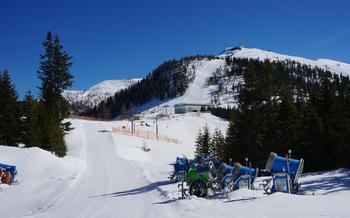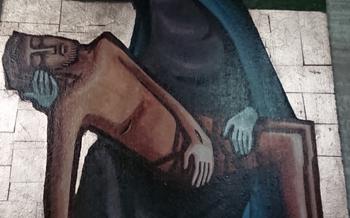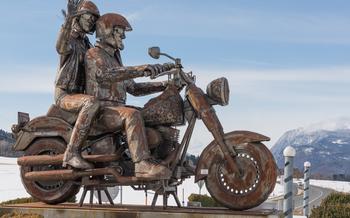
Obervellach Mining Museum
- Obervellach Mining Museum: A Journey into Carinthian Mining History
- Location and Getting There:
- Opening Hours and Admission:
- Exhibits and Displays
- Mining Equipment and Machinery
- Mining Minerals and Rocks:
- Mining Techniques and Processes:
- Life of a Miner:
- Mining Culture and Traditions
- Mining and the Environment:
- Educational Programs and Workshops:
- Souvenirs and Mining Artifacts
- Accessibility for Visitors
- Events and Special Exhibitions
- Insider Tip:
Obervellach Mining Museum: A Journey into Carinthian Mining History
Nestled in the charming town of Obervellach, the Obervellach Mining Museum offers a captivating journey into the rich mining history of Carinthia, a region renowned for its mineral wealth. Founded in 1974, the museum is housed in a beautifully restored 16th-century building that once served as the administrative center of the local mining industry. Through a diverse collection of exhibits, interactive displays, and guided tours, the museum brings to life the fascinating tales of miners, their techniques, and the profound impact of mining on the region's culture and economy.
The museum's mission is to preserve and showcase the legacy of mining in Carinthia, ensuring that future generations can appreciate the region's deep-rooted connection to this industry. It aims to educate visitors about the significance of mining, its historical and cultural importance, and the challenges faced by miners throughout the centuries. By promoting an understanding of mining heritage, the museum contributes to the preservation of Carinthia's unique identity and its role in the broader history of mining in the Alpine region.
Location and Getting There:
The Obervellach Mining Museum is situated in the heart of the charming town of Obervellach, in the picturesque Möll Valley of Carinthia, Austria. Its exact address is Hauptstraße 64, 9821 Obervellach.
To reach the museum from major cities like Vienna or Salzburg, take the A10 Tauern Autobahn and exit at Spittal/Millstätter See. From there, follow the B100 Drautal Bundesstraße towards Obervellach. Once in Obervellach, the museum is conveniently located in the town center, within easy walking distance from the main road.
For those traveling by public transportation, the closest railway station is in Spittal/Millstätter See. From there, take the ÖBB regional train to Obervellach. The museum is just a short walk from the train station.
Ample parking spaces are available in the vicinity of the museum, making it accessible for visitors arriving by car.
Opening Hours and Admission:
The Obervellach Mining Museum welcomes visitors from Tuesday to Sunday, with varying opening hours throughout the year. During the summer season from April to October, the museum is open from 9:00 AM to 5:00 PM, providing extended hours for exploring the exhibits. In the winter months from November to March, the museum observes reduced hours, operating from 10:00 AM to 4:00 PM.
Admission to the museum is reasonably priced, allowing visitors to immerse themselves in the world of mining without breaking the bank. Adults can purchase a standard ticket for a modest fee, while children and students can benefit from discounted rates. Families visiting together can take advantage of special family tickets, offering a cost-effective way to engage the entire family in the museum's offerings.
Guided tours are available for those seeking a more in-depth experience and personalized insights into the museum's collection. These tours are conducted by knowledgeable guides who share their expertise on Carinthian mining history and the significance of the exhibits. Additional fees apply for guided tours, and advance booking is recommended to secure a spot.
The museum recognizes the importance of accessibility and offers various discounts and special offers to ensure that everyone has the opportunity to explore its treasures. Keep an eye out for special promotions, group discounts, and seasonal offers that may be available during your visit.
Exhibits and Displays
The Obervellach Mining Museum boasts a rich collection of permanent and temporary exhibits that provide a comprehensive overview of Carinthian mining history. Visitors can explore interactive displays that showcase various mining techniques, from traditional hand-held tools to modern machinery. The museum's permanent exhibits delve into the science of geology, explaining the formation of minerals and rocks found in the region. Temporary exhibitions often focus on specific aspects of mining, such as the history of a particular mine or the impact of mining on the environment. Interactive displays engage visitors of all ages, allowing them to experience the challenges faced by miners and the significance of mining in shaping the region's history.
Mining Equipment and Machinery
The Obervellach Mining Museum proudly showcases an impressive collection of historic mining tools and machinery, offering visitors a glimpse into the arduous labor and ingenuity that characterized mining operations in Carinthia. These artifacts, meticulously preserved and displayed, provide a tangible connection to the region's rich mining past.
Among the highlights of the museum's collection are replicas of traditional mining equipment used by miners centuries ago. These include hand-operated drills, pickaxes, shovels, and carts, which required immense physical strength and skill to operate. Interactive demonstrations vividly illustrate how these tools were employed to extract valuable ores from the earth's depths.
The museum also houses a remarkable collection of machinery that revolutionized mining techniques in the 19th and 20th centuries. Visitors can marvel at the sheer size and complexity of these machines, including mining locomotives, ore crushers, and ventilation systems. These technological advancements significantly improved efficiency and safety in the mines, while also posing new challenges for the miners who operated them.
Through these exhibits, the Obervellach Mining Museum invites visitors to step back in time and experience the challenges and triumphs of Carinthian miners. The museum's dedication to preserving and showcasing these artifacts ensures that the region's mining heritage remains alive for generations to come.
Mining Minerals and Rocks:
The Obervellach Mining Museum houses an impressive collection of minerals and rocks excavated from the mines of Carinthia. These specimens provide a glimpse into the geological diversity of the region and showcase the variety of minerals found in the local mountains. Each exhibit is accompanied by detailed explanations of its geological significance, allowing visitors to understand the formation and composition of these natural treasures. Interactive displays enable visitors to identify minerals, learn about their properties, and discover their uses in various industries. Storytelling panels bring to life the fascinating tales behind the minerals, narrating their journey from deep within the earth to their display in the museum.
Mining Techniques and Processes:
The Obervellach Mining Museum offers a comprehensive exploration of the techniques and processes employed in mining throughout history. Engaging displays showcase the evolution of mining methods, from rudimentary hand tools to advanced machinery. Visitors can witness demonstrations of ore processing techniques, gaining insights into the intricate processes of extracting valuable minerals from the earth. Interactive exhibits invite visitors to experience hands-on activities, such as panning for gold and learning about the principles of mineral separation. The museum also highlights the differences between historical and modern mining practices, showcasing the technological advancements that have transformed the industry over the centuries.
Life of a Miner:
The Obervellach Mining Museum offers a glimpse into the challenging and rewarding life of a miner. Through interactive exhibits and personal stories, visitors gain insights into the daily routines, struggles, and triumphs of these hard-working individuals. From the early morning wake-up call to the descent into the dark and dangerous mine shafts, miners faced a myriad of hazards, including cave-ins, flooding, and exposure to toxic gases. The museum highlights the camaraderie and resilience that miners developed to overcome these challenges, as well as the social and cultural aspects of mining communities. Visitors can learn about the miners' families, their traditions, and the impact of mining on their way of life. Personal anecdotes and artifacts bring the stories of these brave men to life, offering a deeper understanding of the human side of mining.
Mining Culture and Traditions
The Obervellach Mining Museum not only delves into the technical aspects of mining but also explores the rich cultural heritage associated with it. Mining has deeply influenced the region's traditions, shaping the lives and identities of its people. Visitors can learn about the evolution of mining culture in Carinthia, from its humble beginnings to its industrial heyday. Traditional mining festivals and events, such as the annual "Knappenfest" (Miners' Festival), showcase the camaraderie and pride of the mining community. Mining songs and stories, passed down through generations, offer a glimpse into the lives and struggles of the miners. The museum also highlights the role of mining in shaping local identity, showcasing how the region's mining heritage has influenced its language, customs, and art.
Mining and the Environment:
The Obervellach Mining Museum also sheds light on the impact of mining on the environment. Mining activities can have a negative impact on the surrounding ecosystem, including air and water pollution, soil contamination, and habitat destruction. The museum presents exhibits that highlight these environmental concerns and showcases efforts made to minimize the environmental damage caused by mining.
Interactive displays and educational programs emphasize the importance of sustainable mining practices. Visitors can learn about the latest technologies and techniques used to reduce pollution, conserve resources, and protect biodiversity. The museum also showcases innovative approaches to mine reclamation and restoration, demonstrating how former mining sites can be transformed into thriving ecosystems.
By raising awareness of the environmental implications of mining, the Obervellach Mining Museum encourages visitors to consider the delicate balance between resource extraction and environmental protection. It promotes responsible mining practices and inspires visitors to become advocates for sustainable development.
Educational Programs and Workshops:
The Obervellach Mining Museum offers a range of educational programs and workshops designed to engage students of all ages and provide them with a deeper understanding of mining history and technology. These programs are led by experienced educators who use interactive methods to bring the subject to life.
For school groups, the museum offers guided tours tailored to different grade levels, focusing on topics such as mining techniques, minerals, and the life of miners. Hands-on workshops allow students to try out mining activities, such as panning for gold or identifying minerals.
The museum also offers educational resources for teachers, including lesson plans, worksheets, and multimedia presentations. These resources are aligned with educational standards and help teachers integrate mining history into their curriculum.
In addition to school programs, the museum conducts workshops and events for the general public. These workshops cover various mining-related topics, such as mineral identification, mining techniques, and the history of mining in Carinthia.
Overall, the educational programs and workshops at the Obervellach Mining Museum provide a valuable opportunity for visitors of all ages to learn about the rich mining heritage of Carinthia in an engaging and interactive way.
Souvenirs and Mining Artifacts
The Obervellach Mining Museum offers a unique opportunity to take home a piece of mining history through its well-stocked museum shop. Visitors can browse a wide selection of mining-related souvenirs, including replicas of historic mining tools, minerals, and precious gemstones. There are also books on mining history, geology, and mineralogy for those who want to delve deeper into the subject.
For those seeking truly unique gifts, the museum shop offers a variety of mining artifacts, such as vintage miner's lamps, helmets, and even miniature mining equipment. These artifacts provide a tangible connection to the past and make for cherished collectibles.
The museum shop is conveniently located within the museum, making it easy for visitors to browse and purchase souvenirs after their tour. Whether you're looking for a memento of your visit or a special gift for a mining enthusiast, the Obervellach Mining Museum shop has something for everyone.
Accessibility for Visitors
The Obervellach Mining Museum is committed to ensuring a welcoming and accessible environment for all visitors. Recognizing that accessibility is a fundamental right, the museum has implemented various measures to accommodate visitors with disabilities.
-
Wheelchair Accessibility: The museum's entrance, exhibits, and restrooms are wheelchair accessible, allowing visitors to navigate the space with ease. Ramps and elevators provide convenient access to different levels of the museum.
-
Assisted Listening Devices: For visitors who are hard of hearing, assisted listening devices are available. These devices amplify the audio content of guided tours and presentations, ensuring that everyone can fully engage with the museum's offerings.
-
Multilingual Brochures and Audio Guides: To cater to international visitors and those who prefer different languages, the museum provides multilingual brochures and audio guides. This allows visitors to explore the exhibits in their preferred language, enhancing their understanding and appreciation of the museum's content.
Events and Special Exhibitions
The Obervellach Mining Museum regularly hosts a variety of events and special exhibitions throughout the year, making it a vibrant and dynamic space for learning and engagement. Thematic exhibitions delve deeper into specific aspects of mining history, showcasing rare artifacts, interactive displays, and captivating storytelling. Workshops, lectures, and demonstrations by experts provide visitors with hands-on experiences and insights into the fascinating world of mining. To stay updated on upcoming events, check the museum's website or social media pages. Advance booking is recommended for special events and workshops to avoid disappointment.
Insider Tip:
To truly make the most of your visit to the Obervellach Mining Museum, plan your trip for a weekday morning or afternoon, when you'll likely encounter fewer crowds and have more opportunities for personalized interactions with the museum staff. Take your time as you explore the exhibits, and don't hesitate to ask questions or seek assistance from the knowledgeable guides. For a well-rounded experience, consider combining your museum visit with a trip to the nearby Millstatt Abbey, a beautiful Benedictine monastery founded in the 11th century, or a hike through the picturesque Lieser Valley, renowned for its stunning alpine scenery. After your visit, indulge in a delicious meal at one of the local restaurants in Obervellach, where you can savor traditional Carinthian cuisine, accompanied by the warm hospitality of the region. Don't miss the chance to capture some unique photographs within the museum, especially in the historic mining tunnels, where the interplay of light and shadow creates an evocative atmosphere.









